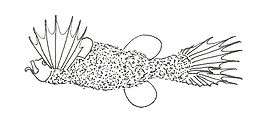Cetomimidae
| Flabby whalefish | |
|---|---|
 | |
| Cetomimus gillii | |
 | |
| Hairyfish (Mirapinna esau) | |
| Scientific classification | |
| Kingdom: | Animalia |
| Phylum: | Chordata |
| Class: | Actinopterygii |
| Order: | Cetomimiformes |
| Family: | Cetomimidae Goode & T. H. Bean, 1895 |
| Genera | |
|
Ataxolepis | |
Flabby whalefish are small, deep-sea cetomimiform fish of the family Cetomimidae. They are among the most deep-living fish known, with some species recorded at depths in excess of 3,500 m (11,500 ft). Juveniles are known as tapetails and were formerly thought to be in a separate family, dubbed Mirapinnidae. Adults exhibit extreme sexual dimorphism, and the adult males were once thought to be exemplars of still another family, Megalomycteridae.[1]
Thought to have a circumglobal distribution throughout the Southern Hemisphere, flabby whalefish are the most diverse family of whalefishes. The largest species, Gyrinomimus grahami, reaches a length of some 40 cm. They are distinguished from other whalefishes by their loose, scaleless skin and lack of photophores.
Description
Living at extreme, lightless depths, adult female flabby whalefish have evolved an exceptionally well-developed lateral line system. Their eyes are either very small or vestigial, and instead this system of sensory pores (running the length of the body) helps the whalefish to accurately perceive its surroundings by detecting vibrations. Named after the baleen whale-like bodies of adult females (from the Greek ketos meaning "whale" or "sea monster" and mimos meaning "imitative"), whalefish have large mouths, and their dorsal and anal fins are set far back of the head. All fins lack spines, and the pelvic fins are absent. The fish also lack swim bladders.
Flabby whale fish are a red to orange-brown color in life, with the fins and jaws in particular being brightly coloured. This is explained because longer electromagnetic wavelengths (such as red and orange) do not penetrate into the whale fish's realm: animals which have evolved at this depth cannot see longer wavelengths, rendering the whalefish effectively black.
Their stomachs are highly distensible, allowing adult females to pursue prey otherwise too large for them to eat. Adult males do not eat at all, their jaws having fused shut during the transformation from their juvenile phase. Males retain the shells of prey consumed while still in the juvenile form, and continue to metabolize these shells through the remainder of their lives. Both traits may have evolved due to extreme food scarcity in the ocean depths.[1]
Though little is known regarding the life history of the flabby whalefish, new discoveries are being made. "[Whale fish] live in the oceanic bathypelagic realm (1000–4000 m) [which is] a nutrient-poor habitat. Most fishes living there have pelagic larvae using the rich waters of the upper 200 m. [The whalefish has remarkable] developmental changes and life-history strategies [that allow it to cope with occupying] such contrasting environments." This species is an "extreme example of ontogenetic metamorphoses and sexual dimorphism in vertebrates." In early 2009, the Royal Society published an article detailing the discovery "that three families with greatly differing morphologies, Mirapinnidae (tapetails), Megalomycteridae (bignose fishes), and Cetomimidae (whalefishes), are larvae, males, and females, respectively, of a single family, Cetomimidae." Apparently "morphological transformations involve dramatic changes in the skeleton, most spectacularly in the head, and are correlated with distinctly different feeding mechanisms. Larvae have small, upturned mouths and gorge on copepods. Females have huge gapes with long, horizontal jaws and specialized gill arches allowing them to capture larger prey. Males cease feeding, lose their stomach and oesophagus, and apparently convert the energy from the bolus of copepods found in all transforming males to a massive liver that supports them throughout adult life."[2]
Like many deep-sea fishes, flabby whalefish are thought to undergo nightly vertical migrations; they feed within the upper 700 m of the water column by starlight, and retreat back to the abyssal depths by daybreak. Judging by the latest studies, the younger whalefish seem to frequent shallower water more than the adults do.
Tapetails
Before a report released in January 2009, the juveniles of the species were thought to belong to a separate taxonomic family Mirapinnidae in the Cetomimiform order, with three genera Eutaeniophorus, Mirapinna, and Parataeniophorus. These "tapetails", as they are also known, had been known exclusively from immature specimens, which live in shallower waters than the adults.[3]
The tapetails are named for their caudal fins, which include a narrow streamer that may be longer than the fish's body. The genus Mirapinna, known as the hairyfish, lacks the streamer, but has multiple hair-like growths on its body. All mirapinnids lack scales and fin rays. Mirapinnids are all small fish, less than 7 cm (2.8 in) in length. They feed on small crustaceans.[3]
References
- Froese, Rainer, and Daniel Pauly, eds. (2012). "Cetomimidae" in FishBase. August 2012 version.
- Classification, diversity and biology of whalefishes and relatives
- 1 2 G.David Johnson; et al. (2009). "Deep-sea mystery solved: astonishing larval transformations and extreme sexual dimorphism unite three fish families". Biology Letters. 5 (2): 235–9. doi:10.1098/rsbl.2008.0722. PMC 2667197
 . PMID 19158027.
. PMID 19158027. - ↑ http://journals.royalsociety.org/content/g06648352k5m1562/
- 1 2 Paxton, John R. (1998). Paxton, J.R.; Eschmeyer, W.N., eds. Encyclopedia of Fishes. San Diego: Academic Press. p. 164. ISBN 0-12-547665-5.
